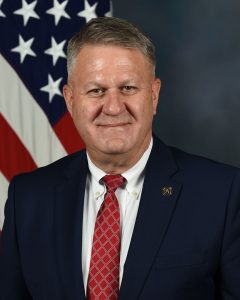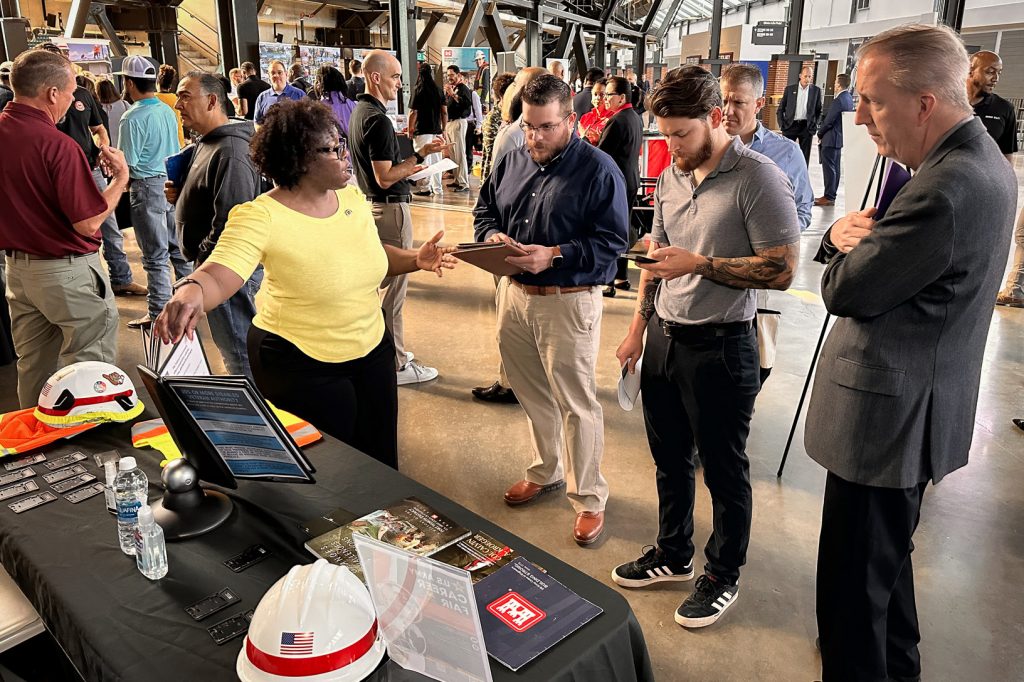
A CORE CATEGORY: Contracting is one of the six major functional areas in the Back-to-Basics framework. Col. Daphne Austin, right, 410th Contracting Support Brigade commander, takes Megan Dake, middle, the deputy assistant secretary of the Army for Procurement, Office of the Assistant Secretary of the Army for Acquisition, on a tour of the 410th facilities in September 2023, at Fort Sam Houston, Texas. (Photo by Spc. Joshua Taeckens, U.S. Army South)
FROM THE DIRECTOR OF
ACQUISITION CAREER MANAGEMENT
RONALD R. RICHARDSON JR.

Ronald R. Richardson Jr., Director, U.S. Army Acquisition Support Center and Director, Acquisition Career Management
By now the workforce is familiar with the changes that impacted the defense acquisition workforce as part of “Back-to-Basics.” Back-to-Basics was the first major overhaul to the Defense Acquisition Workforce Improvement Act (DAWIA) in 30 years, and it was long overdue.
The Army successfully implemented this framework in February 2022. But a lot has happened since we began that transition in the fall of 2020.
We experienced a pandemic.
New DOD Instructions 5000.66 and 5000.02 were published.
International conflicts.
After only a few years we were already asking ourselves if the adjusted requirements from Back-to-Basics still meet the mark.
THE NEED FOR AGILE
The word “agile” is used a lot when talking about what is required for continuous transformation. The need for agile testing, agile development and agile processes. “Agile” methodology, which allows for rapid development, timely adaptation and accelerating delivery, is important in training and keeping our workforce relevant too.
The previous DAWIA framework, as acknowledged by DOD leaders, was a “one size fits all” construct, and requirements ballooned over time to include excessive requirements and limited flexibility.
The desired outcome with Back-to-Basics, as outlined by the Honorable Ellen M. Lord, the former undersecretary of defense for acquisition and sustainment, was that “each Functional Area includes achieving streamlined and restructured certification requirements, identifying prioritized credentials and providing for continuous learning.”
Bottom line: There’s increased commitment to experiential learning; flexibility to add, remove and tailor training opportunities based on current and evolving needs; and recognition that acquisition leaders, supervisors and their employees are empowered to choose the training path that meets their individual, team and organizational needs.
At the DOD level and across the services, acquisition functional area leaders are leveraging this autonomy to ensure required training is fundamental to each and every acquisition position regardless of grade or project, and that a wide variety of continuous learning is available based on the uniqueness of each objective.

YOU ARE THE KEY: When it comes to career development, you are the best person to select a path. Whitney Hartwell, military pay technician, at Redstone Arsenal, Alabama, March 2024. (Photo by Eric Schultz, U.S. Army Financial Management Command)
EMPLOYING COMPETENCIES
Competencies are sets of knowledge, skills, abilities, behaviors and other characteristics that individuals need to perform jobs within their acquisition functional area. It’s important that the training we take time to develop, and ultimately require, is based on identified needs that are reviewed and validated.
To accomplish this, we have functional integrated teams (FITs) that execute a periodic review of functional competencies. The FITs circulate the competency model for comment and often go line-by-line to ensure viewpoints are heard from service and 4th Estate representatives—all the agencies and field activities in DOD that are not affiliated with a miliary branch or combatant command. This collaboration is critical in providing each service and the 4th Estate the opportunity to comment on the validation process, and ultimately ensures the competencies are applicable across DOD.
The Defense Acquisition University (DAU) is also a big part of this process, ensuring functional area certification training aligns with these competencies.
DAWIA certification training requirements contain competencies that are core competency elements across each functional area, while competencies deemed to be “specialty” are often left for continuous learning, credentials or assignment specific training. While the DAWIA required training provides for a strong baseline, it is incumbent upon each workforce member to work with their supervisor to identify additional training that may be needed taking into account new acquisition authorities, pathways, agile methodology, digital transformation and real-world events.
The COVID-19 pandemic forced us to look at how we manage and share information, and also how we contingently plan for supply chain issues.
The DoD Instruction 5000.02—updated in 2022—implemented the Adaptive Acquisition Framework, which enables us to deliver effective, suitable, survivable, sustainable and affordable solutions to the end user in a timely manner. This framework impacts everyone across the acquisition community and necessitates broad understanding.
The recent conflicts, such as the one in Ukraine, are another example of our workforce needing to pivot. Within a year, the Army provided thousands of pieces of equipment to Ukraine and, in turn, had to quickly replace those items. These lessons learned demonstrate our need to train the workforce how to accelerate the purchasing and delivery of systems.
We’re also looking to incorporate more systems and digital engineering training across functional areas. What we’ve seen over just the last few years are the rapid changes to system integration, testing, etc., and it impacts all acquisition positions in some way. It’s important that all Army Acquisition Workforce members are competent in these areas; not necessarily a certified expert but to have a basic level of understanding.
| DID YOU KNOW?
The competencies for each Acquisition Functional Area are listed on the USAASC website at https://asc.army.mil/web/dacm-office/functional-areas/#functionalareas. |

WORKFORCE ACQUISITION: Sabrina Thomas, a talent acquisition specialist with the U.S. Army Corps of Engineers (USACE) Little Rock District, speaks with potential candidates about opportunities with USACE during a whole Army career fair in April 2024. Agile methodology helps keep the acquisition workforce relevant. (Photo by Richard Bumgardner, USACE)
CONCLUSION
Thankfully, we have an agile, adaptive process in place with the FITs that allows our acquisition functional leaders to discuss and make critical updates so that our workforce can remain trained and ready. While DAWIA certification remains your bus ticket, it’s not the final stop at your destination.
As I’ve mentioned in previous DACM columns, the best person to develop your career is you, in collaboration with your supervisor. My office will make sure you have the basic skills required to do any job within your functional area, but self-awareness and taking advantage of additional training and education opportunities are what will make you successful in that job. DAU Credentials and the various leader development programs available to you can take you from the fundamentals to expert.







